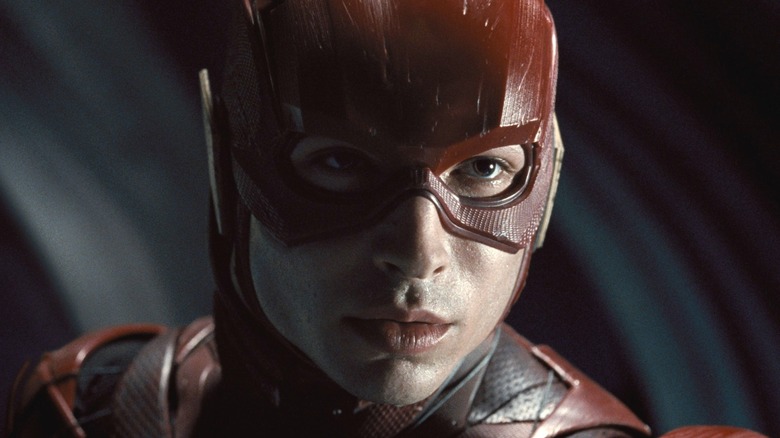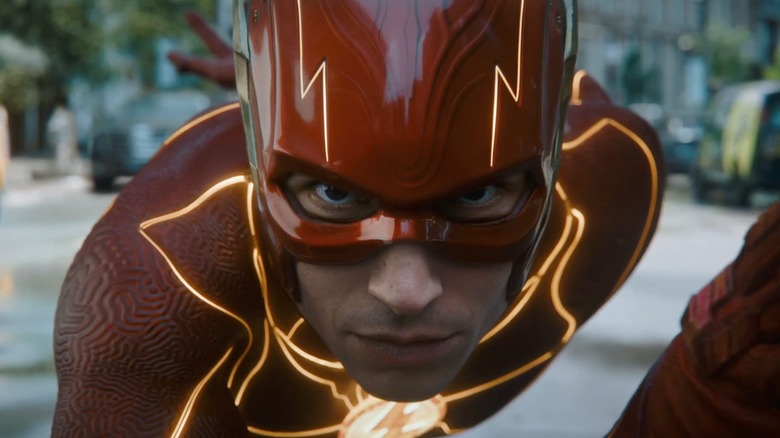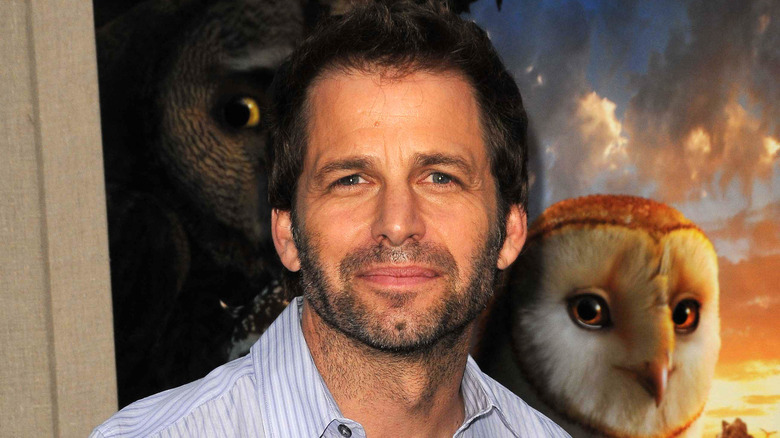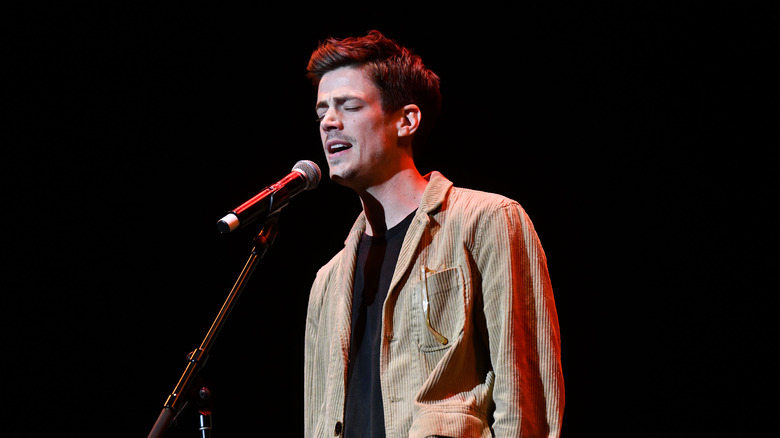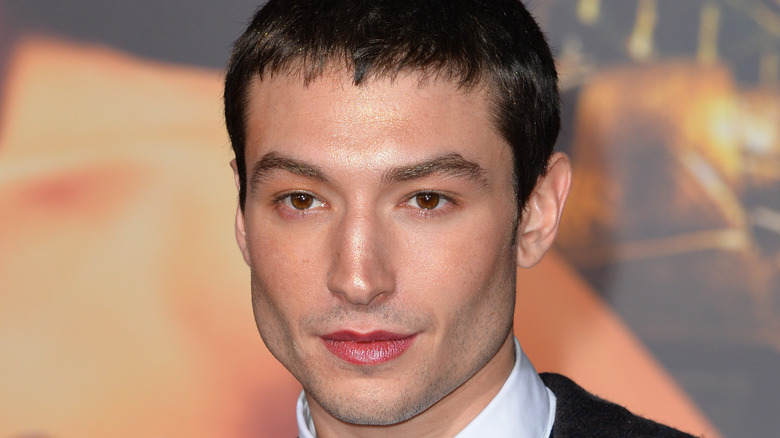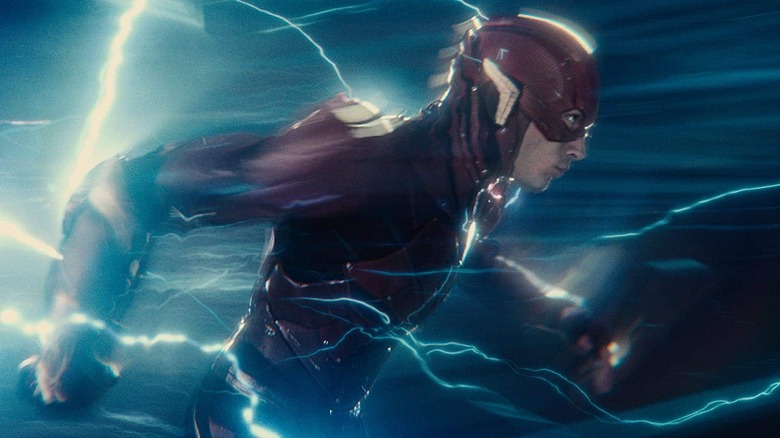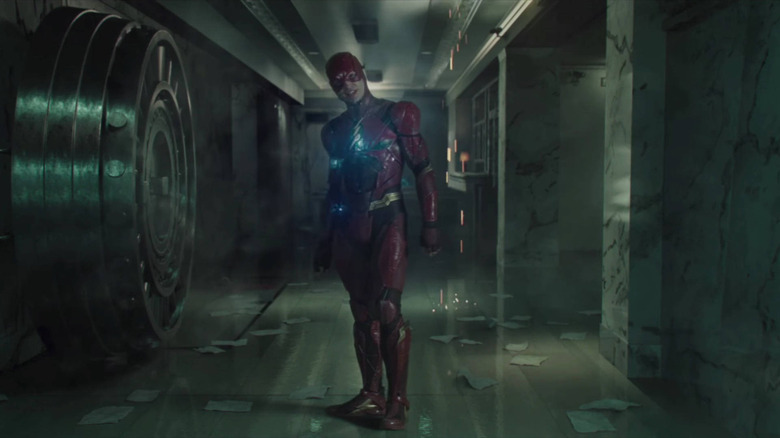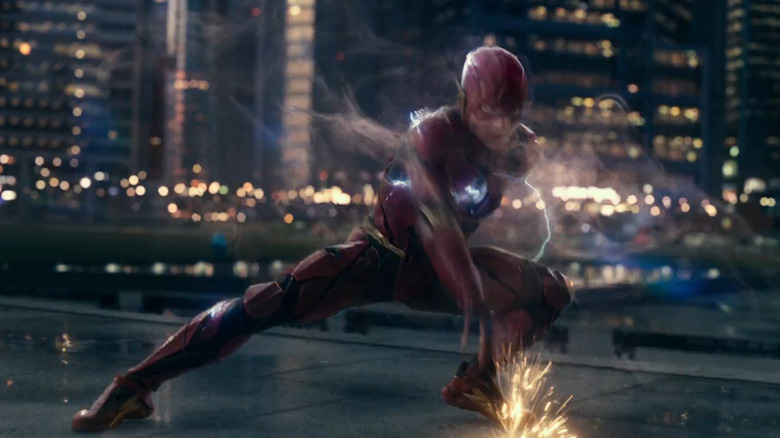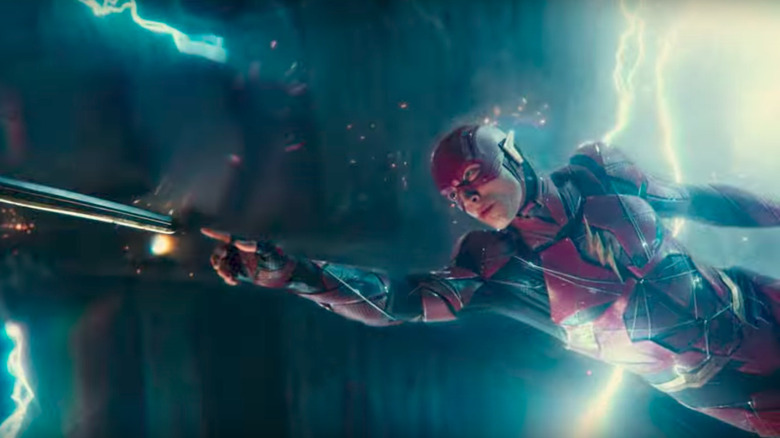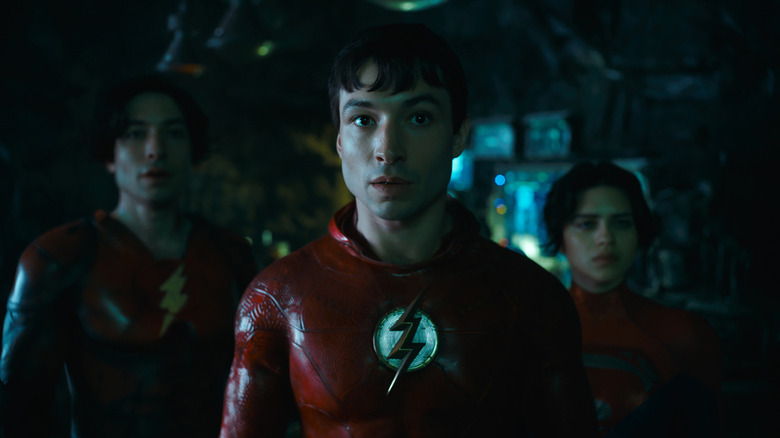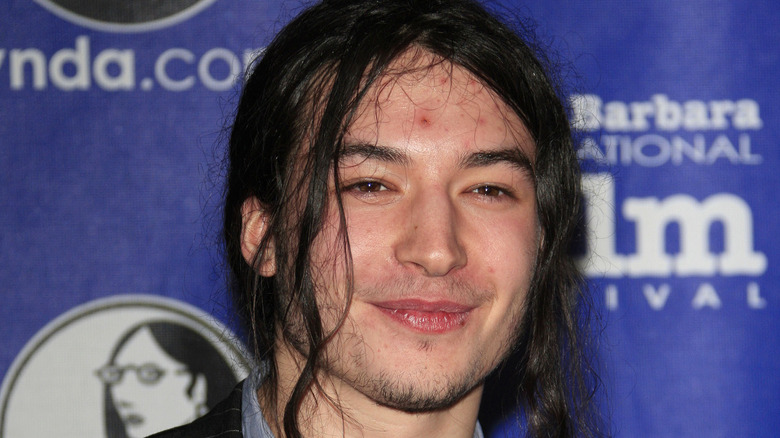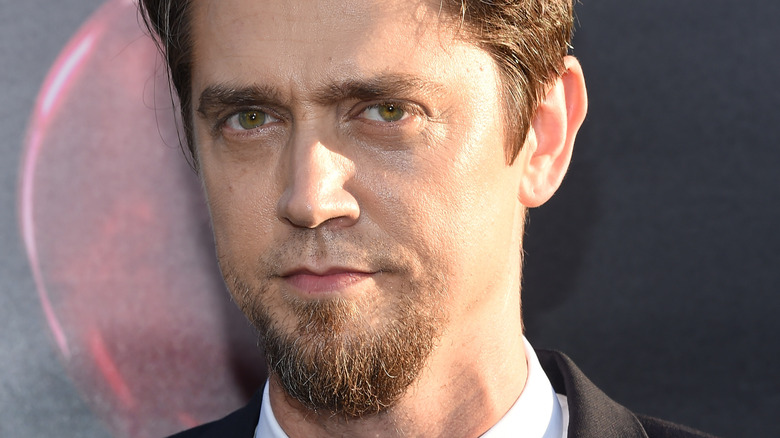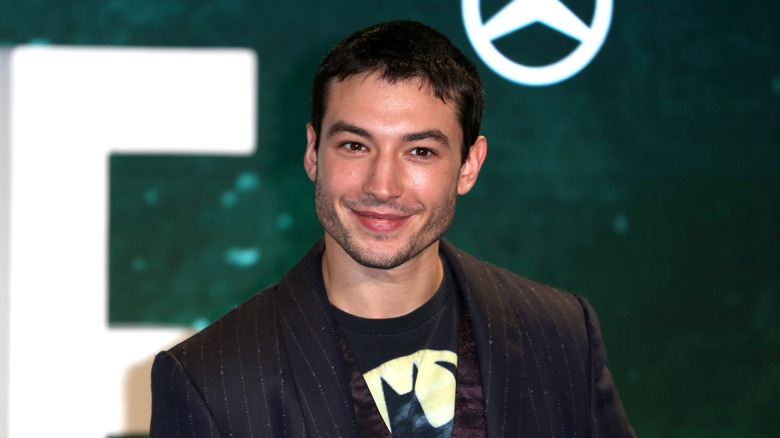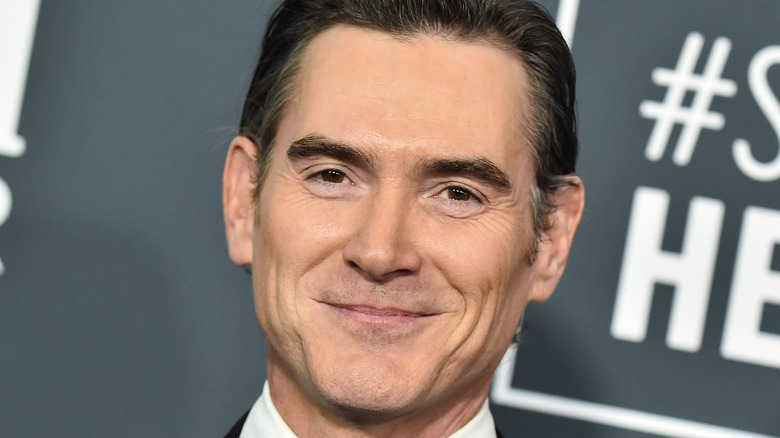The Untold Truth Of The DCEU's The Flash
Thanks to an appearance in "Batman v. Superman: Dawn of Justice," Ezra Miller's Barry Allen, aka The Flash, became a prominent part of the DC Extended Universe even before the characters solo star vehicle "The Flash" made it to movie theatres. After appearing in "Dawn of Justice," this superhero managed to appear in both versions of "Justice League" and make cameo appearances on TV shows like "Arrow" and "Peacemaker." All of these instances of Miller's The Flash splashing across the big and small screen reinforce the prominence of the first live-action film incarnation of one of the most iconic figures in the DC Comics pantheon. For a multitude of obvious reasons, the DC Extended Universe version of The Flash is an important and highly famous figure.
However, even considering the ubiquity of this incarnation of the super-speedy character, the DCEU iteration of The Flash is chock full of details and facts that even ardent fans of this shared continuity aren't aware of. These include how Ezra Miller got the role in the first place, as well as other facets of the character like the visual effects techniques used to bring instances of The Flash moving at remarkable speeds to life. Here is the untold truth of the DC Extended Universe's version of The Flash, whose backstory and careful development process only reaffirm what a fascinating and multifaceted take this vision of the superhero is.
The earliest rumblings of The Flash in the DCEU
After "Man of Steel" managed to exceed $650 million worldwide, it was apparent that this production would not be a one-off effort. Not only would Henry Cavill's Superman be returning in future blockbusters, but teases at Wayne Enterprise during "Man of Steel" indicated that this production would be, much like "Iron Man," the start of a broader interconnected universe. This would pan out just a month after "Man of Steel" was released when Zack Snyder took the stage at the Warner Bros. panel at the San Diego Comic-Con to announce the sequel to "Man of Steel." That project would come to be known as "Batman v. Superman: Dawn of Justice."
In reporting on this development, The Hollywood Reporter divulged that Batman and Superman would not be the only superhero with their own dedicated films in the planned DCEU. The site reported that a "Justice League" film was set for a 2017 debut, and before then, audiences would see "The Flash" zoom into theaters in 2016. With Superman getting relaunched for the 21st century, it appeared Warner Bros. now wanted to turn its attention to a crimson speedster.
The eventual reveal in 2014 of the expansive slate of DCEU movies Warner Bros. had planned confirmed the existence of a "Flash" movie, but now its release date had shifted to 2018. Still, having a "Flash" film be discussed this early in the existence of the DCEU spoke highly to the character's enormous popularity.
Zack Snyder's thoughts on whether or not The Flash is faster than Superman
Zack Snyder would end up utilizing Ezra Miller's version of The Flash quite frequently in his time with the DC Extended Universe, with the character appearing in "Batman v. Superman: Dawn of Justice" and both cuts of "Justice League." However, Snyder's connections to this superhero were apparent long before Ezra Miller was even cast in the role. Snyder and The Flash were connected all the way back to when the filmmaker was promoting the theatrical release of "Man of Steel." During an interview with Digital Spy, Snyder was asked a question that's captivated the minds of geeks for decades — which DC superhero is faster, Superman or The Flash?
In response to this matter, Snyder conceded that "in a straight 50-yard-dash," The Flash would have the upper hand. However, Snyder also felt that, eventually, Superman would be able to overtake this famous speedster simply because of his enormous power. Snyder's initial comments align with the conventional wisdom in DC Comics lore, which states that The Flash is indisputably faster than Superman.
The interviewer then concluded this query by jokingly asking if Snyder would resolve this question in a potential "Justice League" movie. In hindsight, this is an especially amusing comment since the theatrical release of "Justice League" features a credits sequence where The Flash and Superman prepare to race each other.
Why Grant Gustin wasn't cast as The Flash in the DCEU
Just a month before Ezra Miller got cast as the DC Extended Universe version of The Flash, the CW premiered "The Flash" starring Grant Gustin as the titular superhero. Given that Gustin was in the role first, not to mention the initial widespread popularity of the series he headlines, it was understandable that people would be curious to see if Gustin would make the leap from the small screen to the big screen. Once "Batman v. Superman" came out, though, Zack Snyder made it apparent that Gustin was never considered to reprise his role as The Flash.
Per Entertainment Weekly, Snyder noted that the tone of Gustin's "The Flash" TV show did not gel with the aesthetic of his DCEU titles, necessitating someone else, like Ezra Miller, to take over the part. Beyond that, Snyder also noted that the DCEU had committed to a "multiverse" concept, allowing multiple actors to portray the same superheroes across different dimensions. Having Gustin play The Flash across both film and television was seen as a waste of the opportunities provided by the multiverse framework. While Gustin was passed over in favor of Ezra Miller for the DCEU take on The Flash, he would rub shoulders with the big-screen version of The Flash in a 2020 crossover episode.
How Ezra Miller got cast in The Flash
In October 2014, Ezra Miller was cast as The Flash in the DC Extended Universe. It was an impressive casting coup that solidified the first theatrical live-action incarnation of one of the most famous DC superheroes of all time. It also brought another acclaimed artist into this nascent franchise since Miller was hot off their work in dramas like "We Need to Talk About Kevin" and "The Perks of Being a Wallflower." A few months after this news first broke, Miller offered some clarity on how they secured such a significant role.
Talking to MTV (per Collider), Miller recalled how their first glimmer of being up for the role of The Flash came when they were chilling in a secretive Costa Rico destination. Being off the grid didn't deter the filmmaker behind "Man of Steel," though. Miller's agent called to say that Zack Snyder was on the phone and needed to talk about a prospective role in the DCEU. A shocked Miller immediately reached out to the filmmaker. From there, Snyder engaged Miller in a lively conversation mapping out the expansive plans for The Flash in the DC Extended Universe, with Snyder already convinced that Miller would be playing the character. Enamored with all this conviction and ambition, Miller didn't hesitate to take on the part. After just this phone call, the trajectory of both Miller's career and the DC Extended Universe would never be the same.
What character sent The Flash back in time in Batman v. Superman?
The first appearance of The Flash in the DC Extended Universe comes unexpectedly right after Bruce Wayne awakens from having a nightmare about a post-apocalyptic encounter with Superman. A version of Barry Allen from the future appears out of nowhere, decked out in a unique outfit suggesting the technological capabilities of the era he is arriving from. After realizing that he's gotten there "too soon," Allen then informs Wayne that "Lois Lane is the key" before vanishing. It's a sudden and unorthodox way to introduce this pivotal superhero into DCEU lore and leaves many questions for the viewer to ponder. The most important question, however, is who exactly sent this superhero back in time?
Per CBR, Zack Snyder would eventually reveal during a "Batman v Superman: Dawn of Justice" watch party that a future version of Victor Stone, aka Cyborg, working alongside the remaining members of the Justice League, was the one that sent The Flash back in time. This was all done to inspire a younger Bruce Wayne to engage in actions that would prevent Lois Lane from being murdered by Darkseid, a tragic event that sent Superman spiraling over to the dark side. Cyborg having a hand in Flash's time travel escapades also lines up with how Cyborg was supposed to be a close ally to The Flash, which once included a major role in the planned solo movie.
Where was The Flash's Suicide Squad cameo shot?
Early on in David Ayer's "Suicide Squad," the backstory for Captain Boomerang is outlined, specifically concerning how he wound up imprisoned. This story is told in a flashback sequence where Captain Boomerang is shown robbing a bank. In the middle of this illegal activity, he has an encounter with his primary rival from the comics, The Flash. After some wry comments about Captain Boomerang's cohorts, The Flash quickly dispatches the villain. With that, this Australian criminal is sent to jail, making him available for the events of "Suicide Squad."
This cameo appearance from Ezra Miller's speedy superhero is one of many ways "Suicide Squad" connects explicitly to the broader DC Extended Universe canon. This is reflected in how "Suicide Squad" director David Ayer didn't oversee this scene. Instead, this cameo was directed by Zack Snyder, according to Cinema Blend. Having The Flash show up for a cameo came up so late in production that by that time, Miller was already in the United Kingdom shooting "Justice League." This didn't turn out to be a problem, though, as Snyder shot all of Miller's footage in between takes on "Justice League." Working within a cinematic universe like this is rarely a solo artistic process, and the participation of Snyder in "Suicide Squad" reflects that nicely.
Warner Bros. rejected the initial Flash-centric finale of Justice League
The finale of "Zack Snyder's Justice League" sees The Flash assist the titular superhero team in saving the day by using his super-speed to turn back time. It's a moment that requires a lot of concentration on the part of The Flash, but he manages to defeat the odds and give the various members of the Justice League one more shot at taking down Steppenwolf. This climax has proven popular with fans of the movie, to the point that the sequence even won the #OscarsCheerMoment prize at the 94th Academy Awards. Taking all of that into account makes it extra fascinating to realize that Warner Bros. initially was vehemently opposed to this set piece being the finale to "Justice League."
Talking to Yahoo, Zack Snyder said that Warner Bros. was always uncomfortable with the idea of The Flash engaging in time travel in the climax of "Justice League." Snyder didn't further explain why the studio was so opposed to this concept, which is odd considering that it's rooted deeply in some of the most iconic comic book stories involving The Flash, including the iconic "Crisis on Infinite Earths." While Warner Bros. would eschew this planned finale for the theatrical cut of "Justice League," the sequence was restored for "Zack Snyder's Justice League." Given the eventual praise and accolades the set-piece scored, it appears Snyder's creative instincts were right on the money here.
The visual effects techniques used to realize The Flash's superspeed
The Flash is far from the first instance of a character with super speed getting realized in a big-budget superhero film. Projects like "X-Men: Days of Future Past" and "Eternals" have previously demonstrated the assorted pieces of visual effects wizardry employed to render these powers in as fantastical a manner as possible. This trend continued with the DC Extended Universe version of The Flash, a character who required imaginative visual effects techniques to properly render the moments where he leaps into action at enormously fast speeds.
A video promoting "Zack Snyder's Justice League" detailed a sequence in which Barry Allen suddenly leaps in to save Iris West to demonstrate the visual effects used to realize this character's superpowers. Specifically, unique forms of "color shift and refraction" were employed to depict Barry Allen moving across the landscape at an extremely quick rate. This set piece and certain other Flash sequences were also shot against green-screen backdrops to ensure every detail of the character's surroundings could be properly tweaked if necessary. Snyder was also paying attention to the tiniest elements of Allen's body language whenever he was engaging in superspeed so that something discernibly human could register even with all these digital techniques being employed.
The Flash movie and its assorted release dates
When "The Flash" was first announced as part of the slate for upcoming DC Extended Universe movies, Warner Bros. gave it a March 2018 release date. This would've initially placed the project's debut just four months after "Justice League" was scheduled to premiere and would've also placed Barry Allen's first solo adventure in the same year as "Aquaman." Given that these dates were announced in 2014, there was plenty of time to get everything ready so that "The Flash" could run to its highest box office potential.
However, constant struggles with maintaining a director ensured that "The Flash" would be missing its targeted March 2018 release date. "The Flash" was taken off the Warner Bros. release schedule shortly after director Rick Famuyiwa departed the production. After that, "The Flash" was stuck in release date limbo, though it would finally get a new release date in December 2019 in the form of a splashy July 1, 2022 date. After briefly shifting to a June 3, 2022 date, "The Flash" would later get delayed to a November 4, 2022 slot. That seemed to be the end of "The Flash" shuffling all over the calendar until March 2022, when it was further postponed to June 23, 2023. Now arriving roughly a year after its initial July 2022 date, the constant postponements for "The Flash" reflect all the problems this blockbuster has had to overcome to reach movie theaters.
What Ezra Miller was always focused on when making The Flash
The Flash has existed in various forms in the comics since the 1940s. There's a dense history to this superhero even before considering the various beloved incarnations of The Flash from assorted TV shows and video games. With so much material to draw from, putting together a solo live-action film for the character could be a daunting exercise. What do you chiefly focus on when you're tasked with bringing The Flash to life? For "The Flash" lead performer Ezra Miller, though, there was something very specific they were always targeting when it came to a solo "Flash" feature.
In a November 2018 interview, Miller was upfront about how many times "The Flash" had been massively delayed but noted that this was all done in the pursuit of making the best film possible. Rather than rush something out to make a release date, Miller was hoping to star in something worthy of the creative legacy The Flash had generated. Across the various incarnations of this feature film, Miller always had their eye on making something that could function as "a gift" to fans of The Flash and DC Comics. Even with so much material to work with, Miller and the rest of the crew's focus on properly delivering this "gift" ensured that they wouldn't get bogged down in making this feature.
The various directors of the Flash movie
In the earliest days of making a solo "The Flash" movie, the person attached to direct the production was Seth Grahame-Smith. Hired for the gig in October 2015, Grahame-Smith would have made his directorial debut on this costly blockbuster, though he had a history of working on Warner Bros. tentpoles thanks to his screenwriting on projects like "Dark Shadows." He would depart "The Flash" six months later, leaving this superhero movie without a director. A little over a month after Grahame-Smith left this blockbuster, "Dope" director Rick Famuyiwa would succeed him as the filmmaker entrusted with bringing The Flash to life as a solo film lead.
However, much like Grahame-Smith, Famuyiwa would only last a few months as the director of "The Flash," as he would depart the project by October 2016. From there, Warner Bros. began to take its sweet time securing another director for the project, with recurring rumors pinpointing artists like Robert Zemeckis for the job. Eventually, "Game Night" directors Jonathan Goldstein and John Francis Daley would be recruited to take on "The Flash," though they too would not last long in this position. While the duo would eventually vacate "The Flash," a replacement director swooped in to take over once they left. "It" director Andy Muschietti, the fourth figure to officially sign on to direct "The Flash," would prove to be the person who would end up overseeing the principal photography for the solo outing of this DC Comics mainstay.
Where did Ezra Miller shoot a new Zack Snyder's Justice League scene?
In putting together the long-anticipated "Zack Snyder's Justice League," it quickly became apparent that a few reshoots would be needed to realize this movie's specific creative vision properly. Specifically, many of these actors would need to be reassembled for a new epilogue scene showing the surviving DC Extended Universe superheroes, including Batman, Cyborg, and even supervillain Joker, navigating the post-apocalyptic Knightmare landscape. Also in this sequence would be Ezra Miller's The Flash, though their presence for this shoot was complicated by how they were in the United Kingdom at the time filming "Fantastic Beasts: The Secrets of Dumbledore."
While this was a massive obstacle, Zack Snyder and company would eventually find a way around it. As Snyder revealed during an interview with Beyond The Trailer, Miller shot their moments for "Zack Snyder's Justice League" in London with the crew of the "Fantastic Beasts" film. Snyder sent the actor drawings to indicate his creative vision for The Flash in this sequence and even directed Miller over Zoom. On paper, there were a billion ways it could have gone wrong, but it proved successful. Miller got all his screentime filmed through these unconventional methods and had a noticeable presence in the final Knightmare epilogue of "Zack Snyder's Justice League."
The recasting of Barry Allen's father
In September 2016, Variety revealed that Billy Crudup was attached to the role of Henry Allen, the wrongly incarcerated father of Barry Allen. The plan was for him to show up in "Justice League" before getting another appearance in "The Flash." This was especially intriguing casting given that having this character in "Justice League" meant that Crudup and director Zack Snyder would be reuniting after working together on "Watchmen." However, as "The Flash" faced one setback after another, casting decisions for the motion picture became foggier. There was increasing uncertainty over whether or not Crudup would still be reprising the role of Henry Allen.
At the start of 2021, though, The Hollywood Reporter seemingly confirmed that Crudup was coming back to the new incarnation of "The Flash" directed by Andy Muschietti. This exciting development teased a proper pay-off for Crudup's cameo in "Justice League" years prior. Unfortunately, in March 2021, Variety broke that the role of Henry Allen was getting recast, with "Office Space" leading man Ron Livingston taking over the part. The reason for this was simply scheduling conflicts, as Crudup was not able to leave his commitments on "The Morning Show" to film his part as Henry Allen. Though Crudup's work as Allen lives on in both versions of "Justice League," he wasn't able to remain committed to the role long enough to make it to "The Flash."
